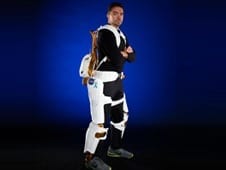X1 has the potential to produce high torques to allow for assisted walking over varied terrain, as well as stair climbing
Marvel Comic‘s fictional superhero, Ironman, uses a powered armor suit that allows him superhuman strength. While NASA’s X1 robotic exoskeleton can’t do what you see in the movies, the latest robotic, space technology, spinoff derived from NASA’s Robonaut 2 project may someday help astronauts stay healthier in space with the added benefit of assisting paraplegics in walking here on Earth.
NASA and The Florida Institute for Human and Machine Cognition (IHMC) of Pensacola, Fla., with the help of engineers from Oceaneering Space Systems of Houston, have jointly developed a robotic exoskeleton called X1. The 57-pound device is a robot that a human could wear over his or her body either to assist or inhibit movement in leg joints.
In the inhibit mode, the robotic device would be used as an in-space exercise machine to supply resistance against leg movement. The same technology could be used in reverse on the ground, potentially helping some individuals walk for the first time.
“Robotics is playing a key role aboard the International Space Station and will continue to be critical as we move toward human exploration of deep space,” said Michael Gazarik, director of NASA’s Space Technology Program. “What’s extraordinary about space technology and our work with projects like Robonaut are the unexpected possibilities space tech spinoffs may have right here on Earth. It’s exciting to see a NASA-developed technology that might one day help people with serious ambulatory needs begin to walk again, or even walk for the first time. That’s the sort of return on investment NASA is proud to give back to America and the world.”
Worn over the legs with a harness that reaches up the back and around the shoulders, X1 has 10 degrees of freedom, or joints — four motorized joints at the hips and the knees, and six passive joints that allow for sidestepping, turning and pointing, and flexing a foot. There also are multiple adjustment points, allowing the X1 to be used in many different ways.
X1 currently is in a research and development phase, where the primary focus is design, evaluation and improvement of the technology. NASA is examining the potential for the X1 as an exercise device to improve crew health both aboard the space station and during future long-duration missions to an asteroid or Mars. Without taking up valuable space or weight during missions, X1 could replicate common crew exercises, which are vital to keeping astronauts healthy in microgravity. In addition, the device has the ability to measure, record and stream back, in real-time, data to flight controllers on Earth, giving doctors better feedback on the impact of the crew’s exercise regimen.
As the technology matures, X1 also could provide a robotic power boost to astronauts as they work on the surface of distant planetary bodies. Coupled with a spacesuit, X1 could provide additional force when needed during surface exploration, improving the ability to walk in a reduced gravity environment, providing even more bang for its small bulk.
Here on Earth, IHMC is interested in developing and using X1 as an assistive walking device. By combining NASA technology and walking algorithms developed at IHMC, X1 has the potential to produce high torques to allow for assisted walking over varied terrain, as well as stair climbing. Preliminary studies using X1 for this purpose have already started at IHMC.
via NASA
The Latest Streaming News: Exoskeleton updated minute-by-minute
Bookmark this page and come back often
Latest NEWS
Latest VIDEO








